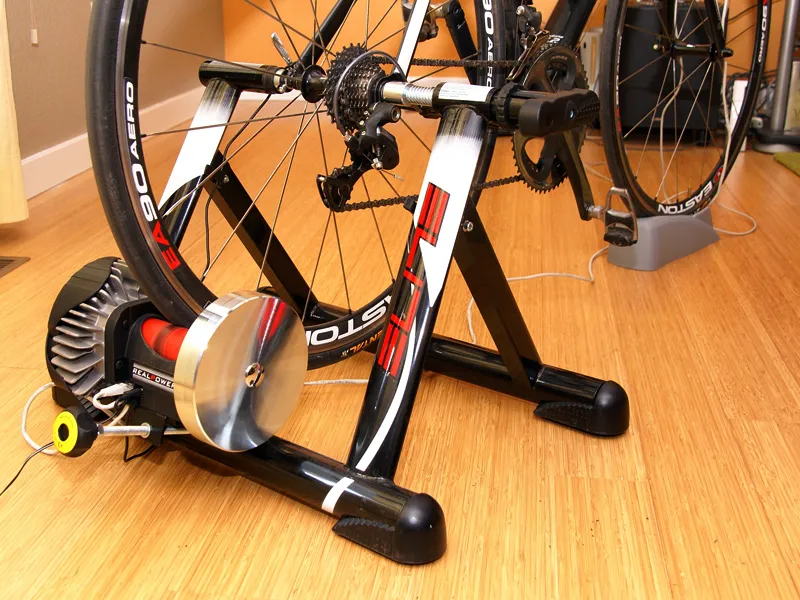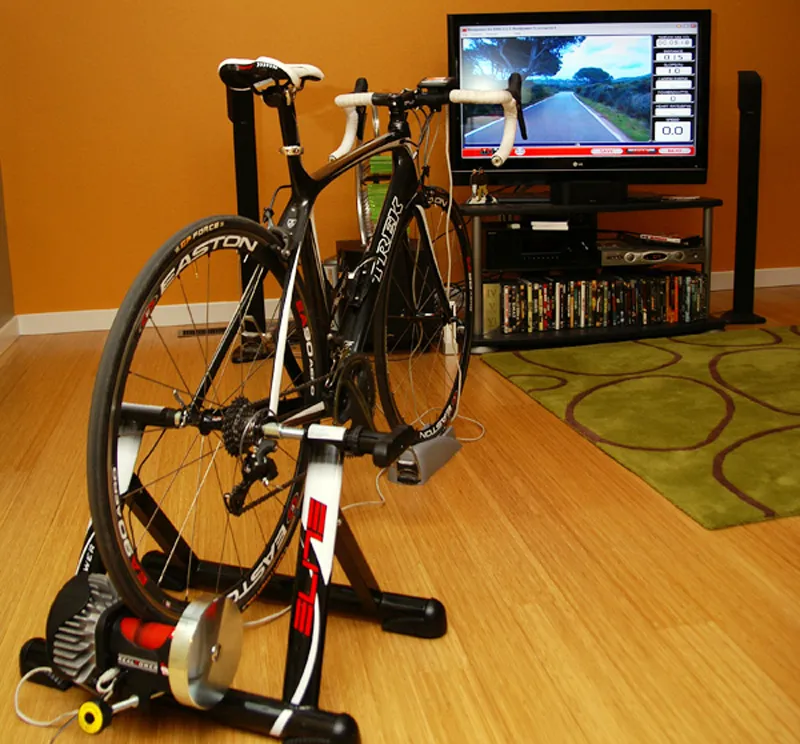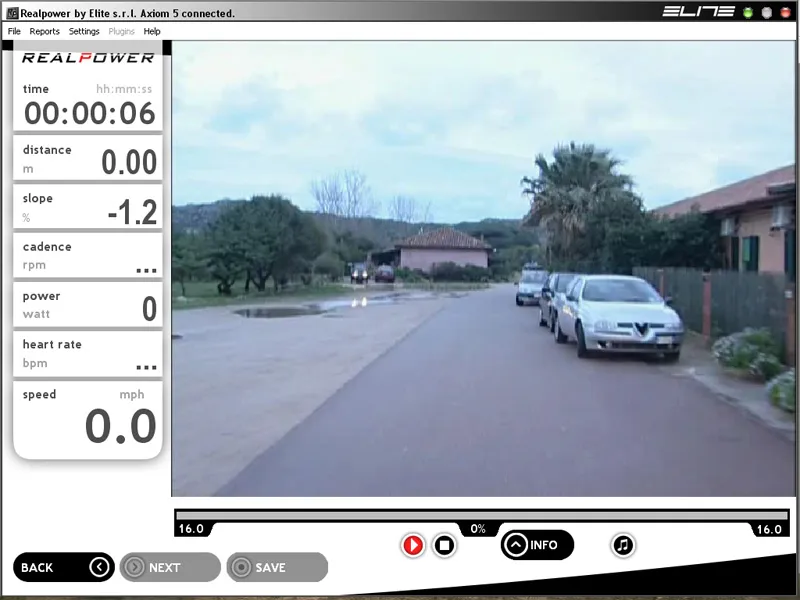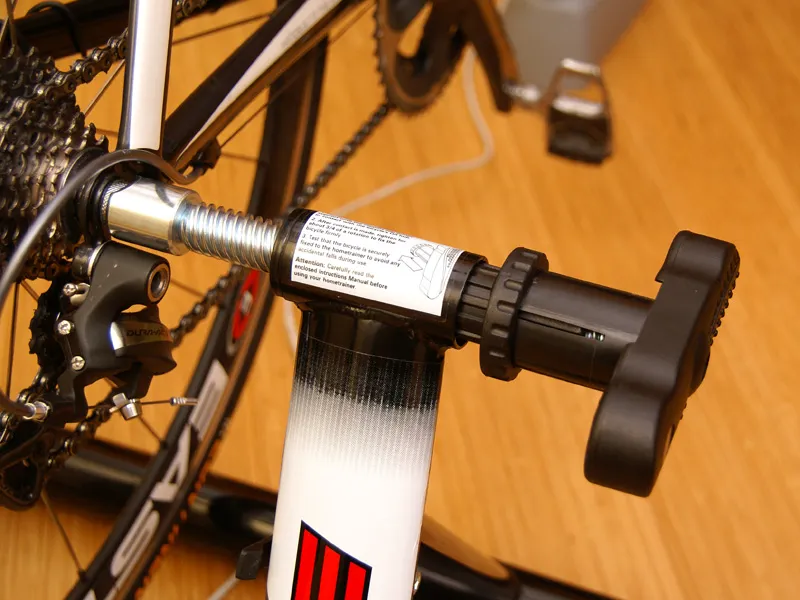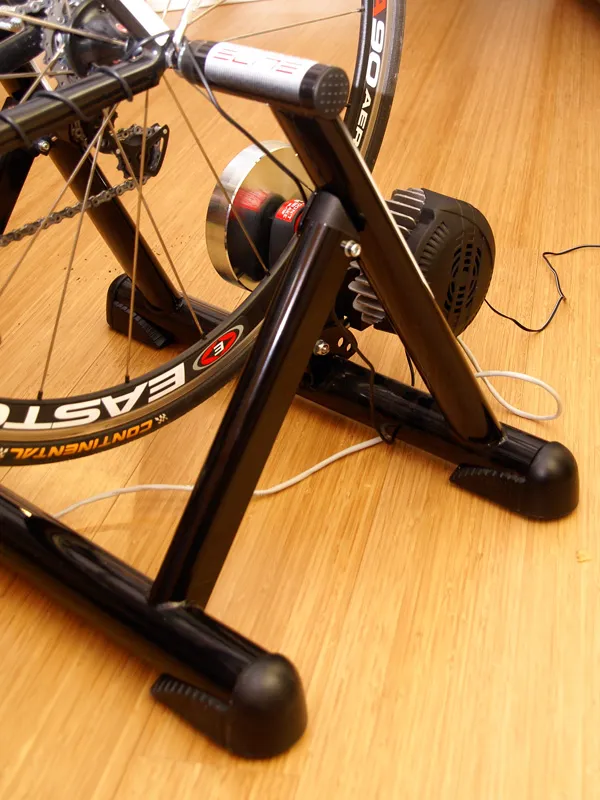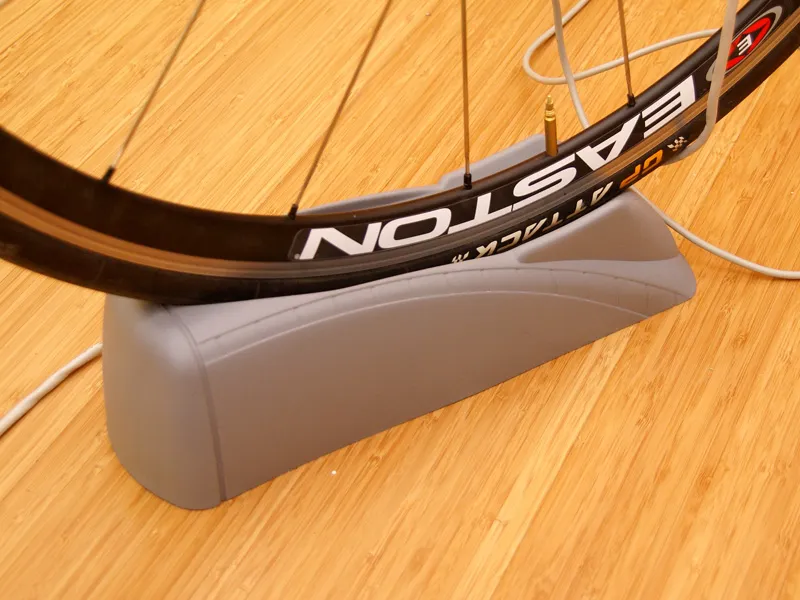Winter’s tight grip still has a hold on much of the world and outdoor riding is still months away for some. The feature-packed Elite RealPower CT trainer is a good way to maintain your fitness indoors – assuming you’re lucky enough to be afford one.
The RealPower CT puts out to pasture the usual practice of plopping down in front of your favorite DVD or television show while riding indoors and replaces it with an on-screen ‘virtual reality’ environment that is far more capable of keeping your attention.
Its folding steel frame and rear-mounted resistance unit look familiar enough but the latter is now hooked up to your home PC. Resistance is computer controlled depending on where you are on any number of RealPower or RealAxiom DVDs, which are filmed by someone actually riding the courses and include such classic routes as the Col du Galibier and the world championship road course in Salzburg, Austria. Fifteen ‘virtual races’ are included with the system and 18 other courses – plus two Giro d’Italia packages with nine stages each – are available once you burn through those.
The concept is simple: if you start heading uphill on the DVD, the resistance increases accordingly; start coming up and over the top of a climb on-screen and you can feel the resistance letting up as you build speed. According to Elite, the RealPower CT can crank out up to 1500W of resistance and simulate up to a 20 percent grade.
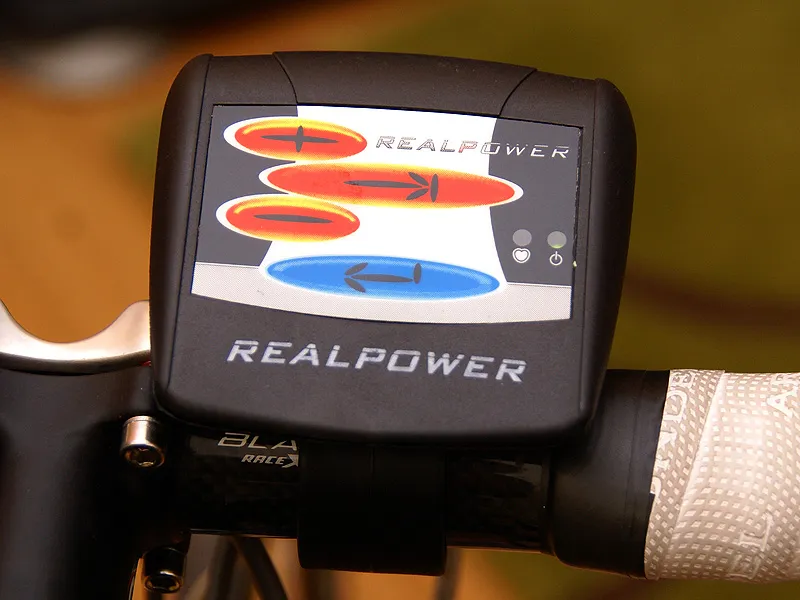
Pretty roads with no cars!
In practice, the RealPower CT is certainly one of the more entertaining (or less boring depending on your perspective) trainers we’ve used. The accompanying videos are surprisingly engaging and a neat little feature allows you to create a soundtrack for your session that plays in the background if you’re so inclined. A wider-angle camera would make for a more encompassing image though and a larger monitor or big-screen television with a computer hookup definitely helps.
The RealPower CT’s on-screen display provides a wealth of information – time, distance, percent grade, cadence, wattage, heart rate – as you virtually roll along and the handlebar-mounted console can bring up separate pop-up displays such as the course elevation profile and start or pause the system.
The software even lets you create sub-courses from the existing files – for instance, if you don’t feel like riding the entire Mont Ventoux climb – and like other trainers of this type, you can create your own workouts from scratch using simple segment length and grade inputs.
The real fun begins when you take advantage of the software’s more advanced features though. Completed sessions can be saved so you can race against yourself later (or yourselves, as you can pull in up to seven of your past performances) and users with a compatible internet connection can race against other RealPower owners in cyberspace.
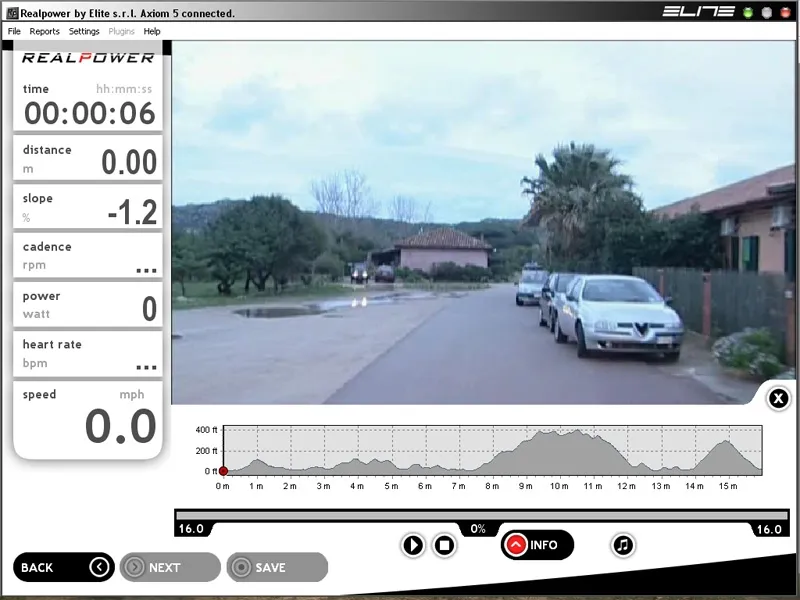
You can even download your actual rides from a compatible GPS device – or the ever-growing crop of route-logging websites such as Bikely.com – and then re-ride them on the RealPower CT.
Have a big event coming up and wish you could pre-ride the course? Recently launched beta software apparently developed in conjunction with Google Maps allows you to create a course online and download the information straight to the RealPower CT software, as long as you can identify the route on a map. You can also build your own course piece by piece by manually defining each segment’s length and percent grade.
Though the map-it-yourself course creation and the downloadable GPS routes are undeniably handy they highlight one of the RealPower CT’s core deficiencies. Unless you’re using the full-blown video mode, the only thing you have to look at on the computer monitor is a bunch of data fields plus a couple of charts outlining the course profile and key metrics such as power and heart rate – in other words, something only marginally more interesting than the display on your usual cyclocomputer (and far more expensive).
Other high-end computerised trainers such as the Tacx Fortius VR and the latest Computrainer at least carry on with video game-like depictions in those situations. While not actual video footage, it still provides much more visual stimulation to keep you going.
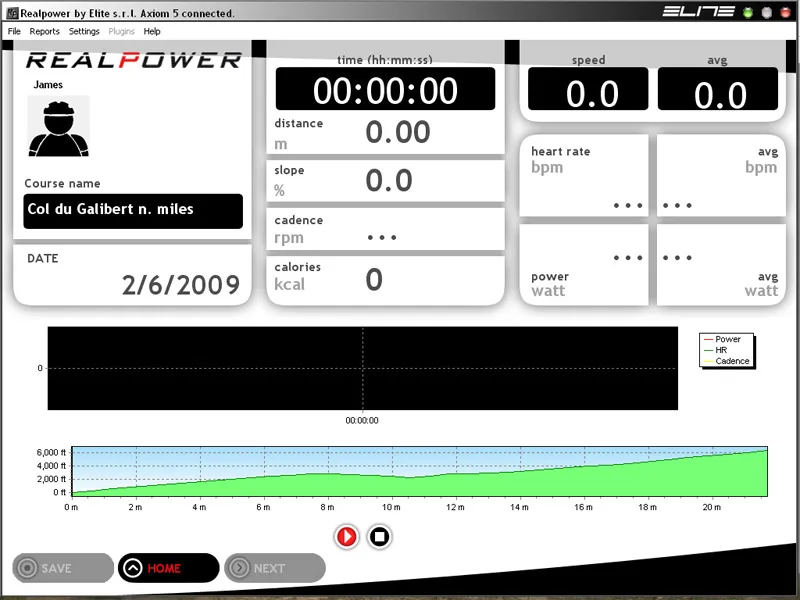
A few glitches
We went ahead and downloaded the latest software version from Elite’s RealAxiom support site yet still suffered some irritating bugs: we were never able to activate the ‘full screen’ mode on the display so it was always cluttered with unnecessary buttons during our rides and we were never able to get the self-competitor function to work (they never left the start line). Moreover, both the GPS and Google Maps download functions are still in the beta phase.
After contacting Elite, it turned out that a far more refined software version had already been coded. This newer software was a vast improvement over what we started out with. Gone were the annoying bugs and perplexing glitches and the interface now had a much more polished appearance. Elite says the new version should be available for public download within days, and it’s certainly worth the hassle.
We also had some initial problems with the power readings, which were often within 10 percent of our reference Powertap but occasionally as far off as 30 percent, particularly on climbs. Though the RealPower CT resistance units come pre-calibrated from the factory, even Elite admits that it can only get within the ballpark since external factors such as tyre pressure, tyre type, roller contact and even temperature can create significant variability.
Thankfully, the system can be calibrated based on your own setup and environment for much more accurate readings. The procedure is pleasantly straightforward – though it involves cranking out and sustaining over 500W twice – and power readings on the RealPower CT and our Powertap were then consistently within five percent of each other.
The software issues are simple enough to solve – especially given Elite’s surprisingly good tech support – though we’d much rather not have to deal with them at all, particularly given the unit’s price tag. Unfortunately, some of the associated hardware is also a little disappointing and there’s no downloadable patch available for a quick fix there.
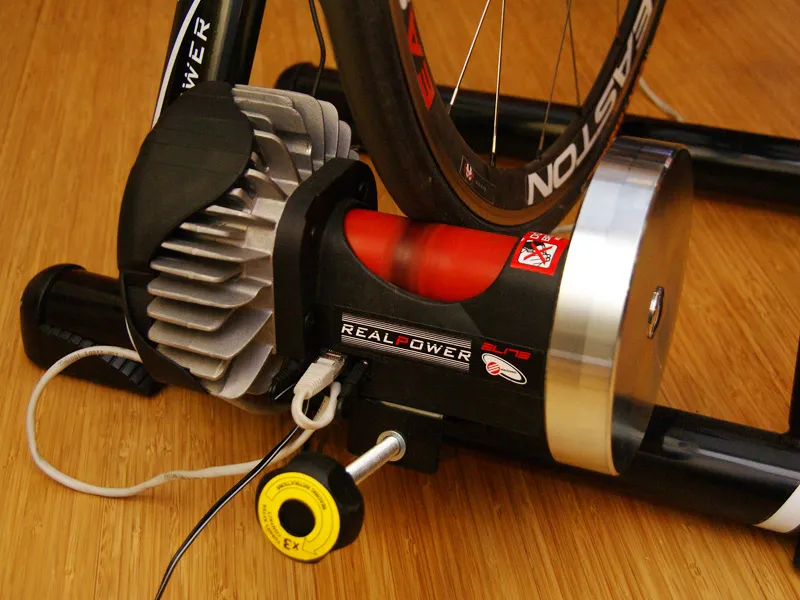
Elite’s Elastogel roller provides excellent tyre grip and is exceptionally quiet but the basic steel frame to which it’s attached has a relatively small footprint – just 60 x 43cm – so it isn’t as stable as we’d like during all-out efforts. The slippery plastic feet tend to slide around on hard surfaces, too, and there is no built-in adjustment to accommodate uneven floors. The frame folds for easier storage but the legs don’t lock in place in either position – nor does the resistance unit with its heavy steel flywheel – and the single-side mounting system is easy to use but prone to flex.
We’d also prefer a cadence sensor that used something other than zip-ties for mounting on the chainstay. It’s secure enough but cumbersome if you plan on using the RealPower CT with multiple bikes – a likely scenario if there’s more than one cyclist in the household. Up front, the handlebar-mounted console fits both standard and oversized bars but it’s bulkier than it needs to be and its low-profile casing doesn’t clear four-bolt stem faceplates.
Moreover, the console’s built-in heart rate monitor (HRM) receiver only works with older 5mHz chest straps, not the newer 2.4GHz ones, and is prone to outside interference as a result (which is why HRM companies switched to 2.4GHz to begin with). Chances are that anyone looking at spending this much on a trainer will have moved on to newer HRM technology some time ago (we had to dig an old strap out of a parts bin). Adding insult to injury is the fact that Elite doesn’t even include a chest strap for your US$1,950 (approx £1,076.59) outlay.
Finally, the RealPower CT is only compatible with Windows computers and Elite has no plans to offer a Mac version.
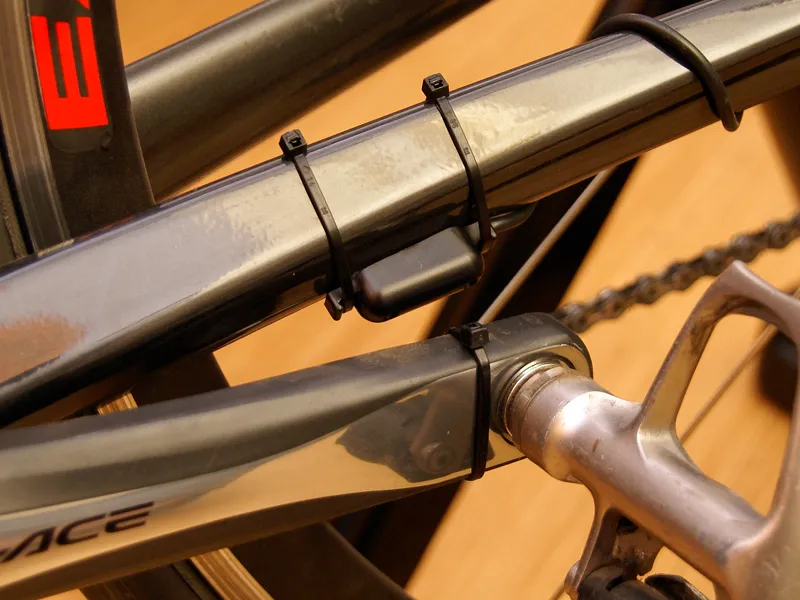
Good, but not as good as riding for real
Compared to nearly any conventional trainer, the Elite RealPower CT is a far more entertaining way to log indoor miles and the gap only grows depending on the severity of your respective winter season. And in spite of its premium asking price, few purchases can carry you through to spring with a modicum of sanity as well as something like this.
Even so, that premium price becomes harder to justify in light of the unit’s less mature stage of development. The hardware isn’t up to scratch for the trainer’s capabilities and the software is clearly a work in progress, though Elite seems to be putting in a fair amount of resources towards bringing it up to speed and has been steadily adding features.
More importantly, the RealPower CT’s slick feature array and eye-catching video environment shine a little less brightly when held up to similar – and less expensive – options like the Tacx Fortius VR or more refined systems like Computrainer, which now offers its own video-controlled environments (at additional cost) and GPS course builder and download functionality, useful training features like SpinScan and more advanced analytical software that isn’t available with RealPower, and a more ubiquitous user network to facilitate remote races.
The price includes the handlebar console, front wheel riser, cadence sensor and magnet, system software, 15 courses and all associated cables and hardware. Additional courses are US$65 (approx £45) each. A 2007 Giro d’Italia package with nine courses is US$265 (approx £185), with the 2008 version retailing for US$295 (approx £205).
